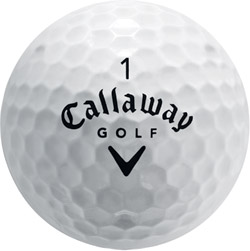 Callaway Golf’s HX Tour golf balls are among the best-selling balls at retail and also enjoy strong usage numbers on tour. While the HX Tour and HX Tour 56 still look longingly up at Titleist’s Pro V1x and Pro V1, Callaway’s flagship balls have actually outpaced Titleist in major championship wins on the PGA and LPGA tours over the last two years (thanks to Annika Sorenstam, Phil Mickelson, Michael Campbell, and even Nike-using Tiger Woods).
Callaway Golf’s HX Tour golf balls are among the best-selling balls at retail and also enjoy strong usage numbers on tour. While the HX Tour and HX Tour 56 still look longingly up at Titleist’s Pro V1x and Pro V1, Callaway’s flagship balls have actually outpaced Titleist in major championship wins on the PGA and LPGA tours over the last two years (thanks to Annika Sorenstam, Phil Mickelson, Michael Campbell, and even Nike-using Tiger Woods).
This year sees the introduction of a revamped HX Tour ball, known as the “Improved” HX Tour. Callaway claims the balls are more durable and more consistent than the original model. We put them to the test to see how they compare to last year’s model.
Design and Technology
The HX Tour golf ball is a three-piece, solid-core golf ball with a urethane cover – a similar construction to most premium golf balls on the market today. Callaway’s Rule 35 golf balls were among the first such balls on the market in 2000, and the HX Tour represents the latest and greatest in the genre. A high-resilience rubber core is surrounded by a ionomer mantle layer and a thin thermoset urethane cover. The cover is only 0.018″ thick, much thinner than many other premium balls, which leaves more room for the core – the distance engine of the golf ball – while still leaving a thick enough layer of urethane to grip the grooves of your irons for plenty of short-game spin.
The most visible part of the HX Tour’s design difference is the patented HEX aerodynamic pattern on the cover. This geometric pattern of hexagonal and pentagonal shapes makes the HX Tour and Callaway’s other balls with the technology (HX Hot, HX Pearl, and Big Bertha balls) the only premium balls on the market without round dimples. The idea behind the HEX pattern is that the construction helps reduce drag during the flight of each shot while adding lift, especially toward the end of the ball’s flight. The HEX pattern also works to keep the ball on its intended line better in windy conditions. The HEX pattern used on the HX Tour and HX Tour 56 balls is more advanced than the pattern used on the company’s non-urethane balls – you can actually see how each indentation is multi-faceted, which gives you an idea of the precision required to produce these balls.
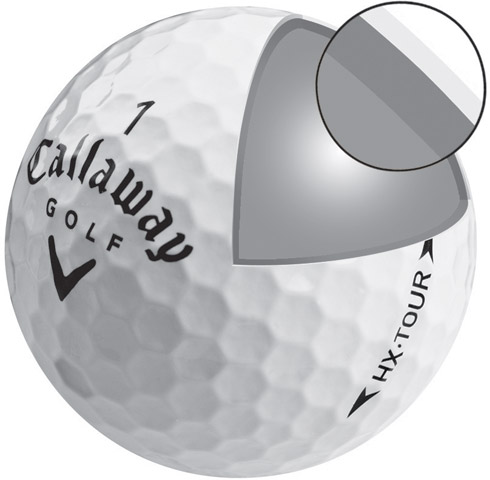
The HX Tour has a high-resilience rubber core surrounded by a ionomer mantle layer and a thermoset urethane cover.
The way the hexagonal indentations fit together on the cover of the HX Tour also virtually eliminates the seam area that is prevalent on most other golf balls. Many experts believe that hitting a golf ball on the seam can increase distance, which is good off the tee when you can place the ball to take advantage of this phenomenon, but more troublesome on iron shots where you can’t be sure of where you’re going to contact the ball.
New to the HX Tour in the “Improved” version for 2006 is the RIM technology Callaway first used in the HX Tour 56 ball last year (and which first showed up on the Ben Hogan Tour Deep ball). The Reaction Injection Molding (RIM) process involves combining two materials into a cavity around the core and mantle layer. The ensuing chemical reaction creates a thermoset urethane cover. In addition to allowing the cover to be ultra-thin, Callaway also claims this process creates a core and mantle layer that are perfectly centered within the cover, which should lead to greater consistency from shot to shot. This centering process also creates six extra-deep hexagonal depressions in the cover, which Callaway refers to as the Sub-Hex design.
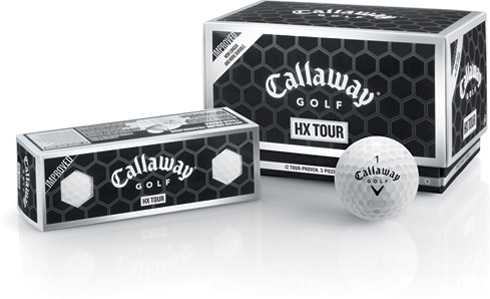
Look for the “Improved” label on your box or you’ll be shredding balls like crazy with your modern wedges and their sharper grooves.
Esthetically, the HX Tour is as simple as black and white. The only other color than the bright white of the cover – a brighter white than the previous HX Tour model – is the black of the Callaway Golf logo on each pole and the HX•TOUR side stamp. (The dot on the side stamp is one way to tell the improved HX Tour from the original.)
Feel and Spin
The HX Tour is the firmer of the two HX Tour varieties. While the HX Tour 56 has a soft, balata-like sound and feel, the HX Tour has a firm, satisfying “click” off irons and the putter and feels especially solid on drives. But like the Titleist Pro V1x, the HX Tour is noticeably softer than Surlyn-covered distance balls.
In terms of spin, the improved version of the HX Tour seemed to spin more on wedge shots than the original version. This was especially noticeable on little finesse shots around the green and partial-swing wedges from inside 80 yards. On shots where I would expect the original HX Tour ball to take a small bounce then roll forward a few feet, the improved HX Tour would stop dead after the bounce – or spin back a foot or two. On chips, the ball seems to really grip the grooves and has a “gummy” feel off the club.
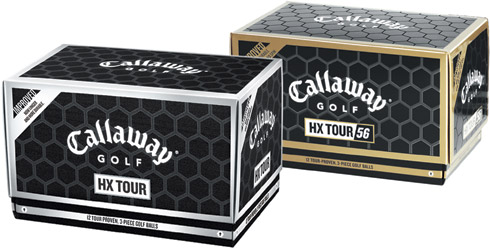
The HX Tour is the firmer, longer, “less-spinny” of the two. The HX Tour 56 is a bit shorter, softer, and spins more.
Off the driver, woods and long irons – where the firm mantle layer comes into play – the HX Tour is a low-spin golf ball. It also launches higher than the HX Hot and HX Pearl three-piece distance balls that Callaway makes (and that I play in the mushy early and late-season conditions around here), which contributes to the HX Tour being a seriously long golf ball. Leading us to…
Distance and Durability
The HX Tour is a seriously long golf ball. It’s the longest ball Callaway makes (the HX Tour 56 is a couple yards shorter off the driver), and comparable to the Pro V1x and other premium three-piece balls. In fact, the improved HX Tour is longer off the tee for me than the original version by about five yards. Not a huge difference, but I’ll take every extra yard I can get. Off the irons, I found the improved HX Tour to produce distances that were virtually the same as the original ball.
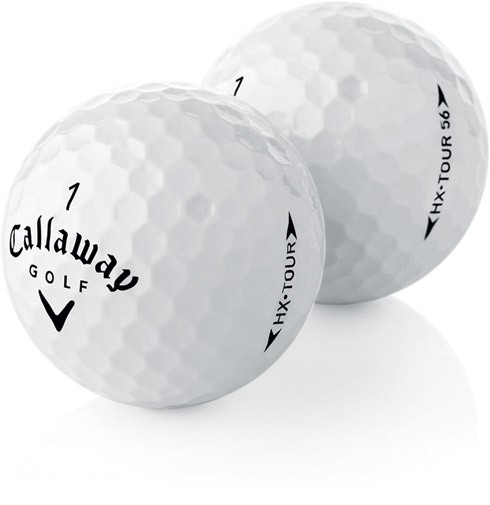
You can see the deeper dimples in this image Look between the “1” and the right arrow on each ball.
Callaway touts the improved HX Tour ball to also have improved durability. With a cover this thin, durability can certainly be a factor. I know some players with aggressive swings who think the HX Tour cover shreds a little too easily. That’s the tradeoff of urethane-covered balls in general, and the improved HX Tour is no different. If you play any of the new wedges with high-spin grooves, you’re going to take some of the cover off the ball on full shots.
In my experience with the HX Tour and other urethane-covered balls, I haven’t found groove marks to impede the performance of the ball – and my R&D contacts back that up. I played an improved HX Tour for 18 holes and while it showed the wear at the end of the round, it was still completely playable. If “durability” to you means “looking brand new for 18 holes,” you’ll probably go through a ball every few holes. But if it means having a playable ball, then you shouldn’t have any trouble with the improved HX Tour from a durability standpoint. It’s a matter of personal preference.
Conclusion
I’ve played all three versions of the HX Tour golf ball, from the prototype “Callaway Black” ball of two years ago to the original retail HX Tour to the new improved model. The change from the prototype to the newest version is incremental, but it is definitely progress. The improved HX Tour is an all-around solid ball – long off the tee, plenty of spin around the greens, stable in the wind.

The HX lineup from Callaway features the HX Tour, HX Tour 56, HX Pearl, and HX Hot. Not shown: the Warbird, which has hexagonal dimples but doesn’t have “HX” in the name.
The HX Tour has met with a solid reaction from Callaway’s tour professionals as well. While some pros stick with older ball models for years after new ones are introduced, every one of Callaway’s staff pros has switched over the the improved HX Tour (or the improved version of HX Tour 56) this year. If validation from tour players matters, there you go. And if it matters what I play, the improved HX Tour is in my bag as well.
The improved HX Tour is available in 12-ball boxes at an MSRP of $50, though the street price is as low as $39.95.

I have been playing the Prov1 & 1x and would not even think of using any other ball… until a friend gave me a couple of the Callaways HX Tour 56 balls. I played 18 with them and I was so impressed that I bought a doz. and have played with them for about 4 weeks now.
I’m an 8 hcp and average 275 drives. I can say that the Prov1x ball is just a little longer (5 – 8 yrds ) but the HX Ball seems to hold the line much better = more fairways.
But the really nice thing that I like is the great feel of the HX 56 off the irons and chip shots around the green. I can’t tell any different in distance betweet the two off the irons.
I would say that the average golfer would benifit from playing the HX 56 ball, not because it will be a magic cure, but because it will play better off the irons. (GIR)
This website answered all of my questions, thanks for the info!
Found a couple of 12 ct. boxes of the HX Tour balls on the clearance shelf of a local department store this winter. Cost? $17.00 a box. After reading this article I am chomping at the bit for Spring to arrive just to see how much of a deal I got!